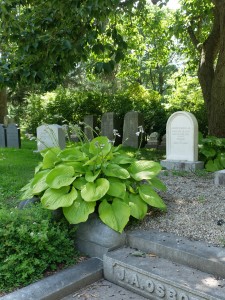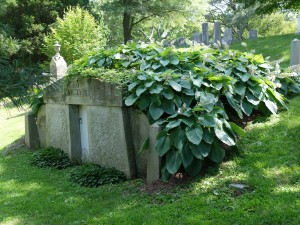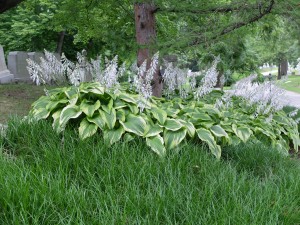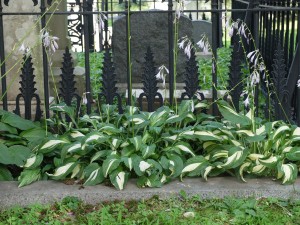Hosta

…The shade full of light without any thickness at all;
You can see right through and right down into the depth
Of the light and shade of the afternoon; there isn’t
Any weight of the summer pressing down…
–David Ferry
Our horticulture department’s most recent plant inventory identifies 4700 trees and 4900 shrubs/dwarf trees growing throughout our living collection. Beneath and between this expansive greenery are pockets and swaths of filtered, as well as dense shade. It is in many of these shaded spots that you will find a wide diversity of Hosta sp., Plantain lily growing. The genus Hosta is native to northeast Asia, and it was named to honor Nicolaus Thomas Host (1771-1834), Austrian physician, botanist. Early plant explorers/physicians with the Dutch East India Company first introduced these bold-leaved, shade-tolerant plants into Europe, from Japan, where they are known as giboshi.
Taxonomists differ on the number of Hosta species, primarily due to their ability to hybridize among themselves, along with a propensity to mutate. Additionally, a lengthy history of nursery propagation for garden usage has resulted in thousands of named cultivated varieties. The American Hosta Society recognizes over 3000 named varieties, but the 2009 book Hostapedia, by Mark Zilis provides descriptions for 7400 hostas. At Mount Auburn, our current plant inventory lists 220 hostas including 9 species, and over 50 cultivated varieties. Herein is a brief sampling of some that you may find here.
 Hosta ‘Sum and Substance’ is one of the larger hostas, with a mature clump able to reach 30-inches high, and 4-to-5-feet wide. The 16-20-inch corrugated, leaves emerge with a chartreuse color that may change to more golden over time, depending also upon sun exposure. This was the 2004 Hosta of the Year winner chosen by the American Hosta Growers Association. This cultivar also received the Royal Horticultural Society’s (RHS) Award of Garden Merit. Look for Hosta ‘Sum and Substance’ on Central Avenue, Spruce Avenue and in Birch Gardens, among other locations.
Hosta ‘Sum and Substance’ is one of the larger hostas, with a mature clump able to reach 30-inches high, and 4-to-5-feet wide. The 16-20-inch corrugated, leaves emerge with a chartreuse color that may change to more golden over time, depending also upon sun exposure. This was the 2004 Hosta of the Year winner chosen by the American Hosta Growers Association. This cultivar also received the Royal Horticultural Society’s (RHS) Award of Garden Merit. Look for Hosta ‘Sum and Substance’ on Central Avenue, Spruce Avenue and in Birch Gardens, among other locations.
 Another large cultivar, Hosta ‘Empress Wu’ allows us to introduce the botanical gardeners’ game of “who grows in your garden?” These hostas often have leaves even larger than Hosta ‘Sum and Substance’ but they are green in color. In the long 4000+-years of Chinese history, there was only one woman empress, Wu Zetian (624-705), who ruled in her own right. Look for our Hosta ‘Empress Wu’ on Fountain Avenue.
Another large cultivar, Hosta ‘Empress Wu’ allows us to introduce the botanical gardeners’ game of “who grows in your garden?” These hostas often have leaves even larger than Hosta ‘Sum and Substance’ but they are green in color. In the long 4000+-years of Chinese history, there was only one woman empress, Wu Zetian (624-705), who ruled in her own right. Look for our Hosta ‘Empress Wu’ on Fountain Avenue.
 Following the same train of thought, we also grow Hosta ‘Frances Williams’ another RHS Award of Garden Merit winner. This hosta has a thick, 12-inch, heart-shaped, variegated leaf with a bluish-green color that has a distinct creamy-yellow edge. Frances Ropes Williams (1882-1969) who grew up in Salem, MA, and later a long time resident of Winchester, MA, was one of the first major hosta hybridizers in the United States. In the 1930’s she introduced a new cultivar of Hosta sieboldiana, originally known as Hosta ‘Yellow Edge’. After going through several other names, a few years before her death this was registered finally in her name. Look for Hosta ‘Frances Williams’ on Azalea Path and Fountain Avenue, among other locations.
Following the same train of thought, we also grow Hosta ‘Frances Williams’ another RHS Award of Garden Merit winner. This hosta has a thick, 12-inch, heart-shaped, variegated leaf with a bluish-green color that has a distinct creamy-yellow edge. Frances Ropes Williams (1882-1969) who grew up in Salem, MA, and later a long time resident of Winchester, MA, was one of the first major hosta hybridizers in the United States. In the 1930’s she introduced a new cultivar of Hosta sieboldiana, originally known as Hosta ‘Yellow Edge’. After going through several other names, a few years before her death this was registered finally in her name. Look for Hosta ‘Frances Williams’ on Azalea Path and Fountain Avenue, among other locations.
Another variegated-leaved hosta is Hosta undulata. This is most often known, and popularly grown, for its green and white leaves, although there are also all green-leaf forms of this. Look for a bright example of this plant on Greenbrier Path.
All of these, as well as other hostas, flower on scapes (leafless stalks) ranging from a few inches to several feet tall. These hold purple, or occasionally white, flowers that will attract hummingbirds, as well as bees and other pollinating insects. On a future summer walk here, spend some time in the shade, and contemplatively survey these and many other cultivars of hostas found throughout our landscape.
…While many a pastime circled in the shade,
The young contending as the old surveyed; …
-Oliver Goldsmith
Leave a Reply